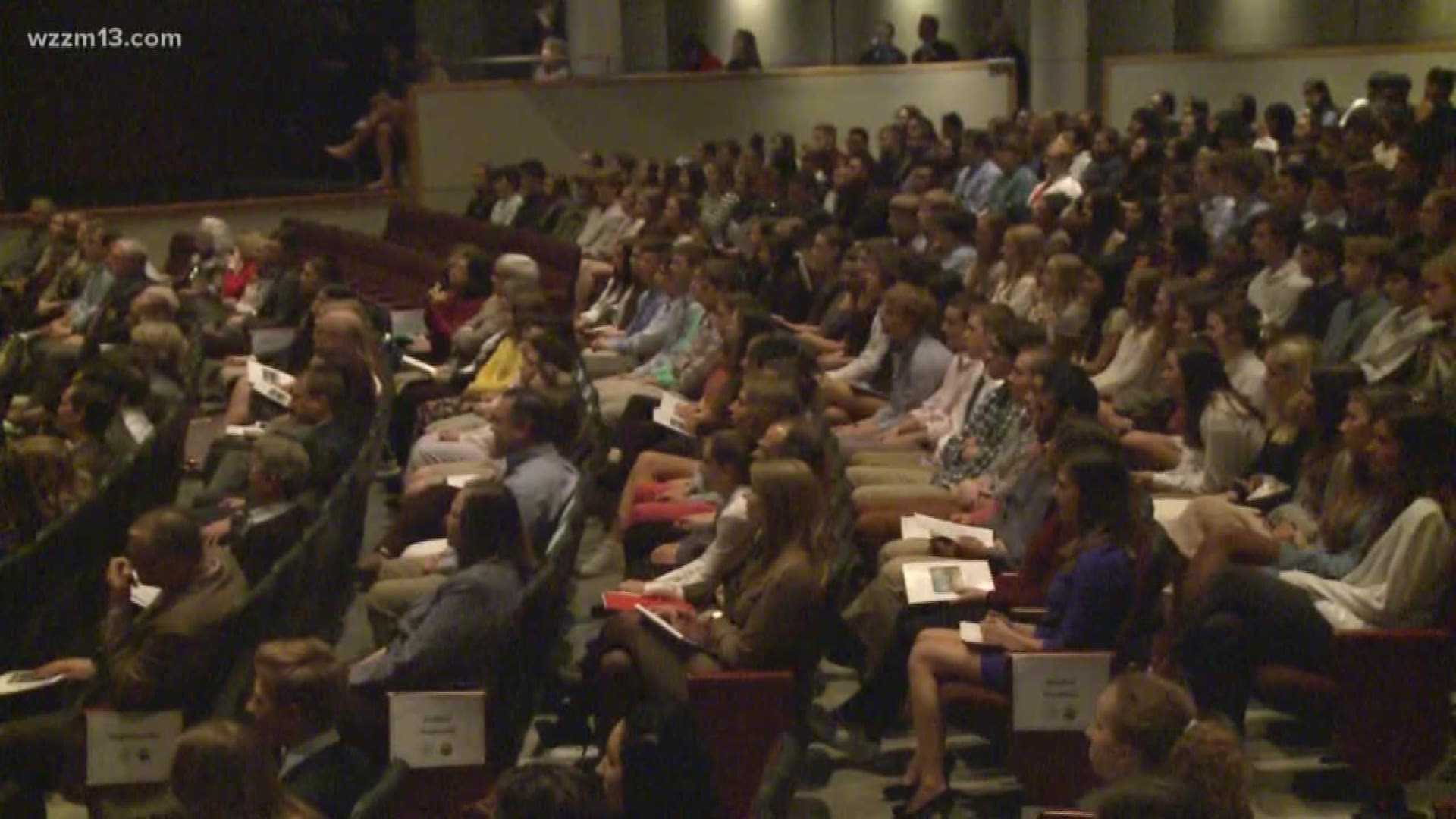EAST GRAND RAPIDS, Mich. - The Michigan Supreme Court packed up and headed to East Grand Rapids Wednesday.
The Justices heard the oral argument in People v Hammerlund at East Grand Rapids High School. More than 500 students from EGR's high school and middle school, East Kentwood, Wyoming, Godfrey-Lee and Portage Northern, attended the hearing.
While the Supreme Court normally hears oral argument at the Michigan Hall of Justice in Lansing, justices and staff travel to various communities as part of "Court Community Connections," which the Supreme Court started as a public education program aimed principally at high school students.
"The Court hopes that by bringing the Community Connections program to the schools, students will have a much better idea of the legal system and what goes into making a decision," Michigan Supreme Court Chief Justice Bridget McCormack said. "We hope the argument helps answer some of the questions that students discussed with their mentors prior to today's event."
SUMMARY OF PEOPLE v. HAMMERLUND
On September 30, 2015, at about 2:20 a.m., defendant Hammerlund was driving home from her job as a bartender when she collided with a guardrail and concrete barrier on a highway off-ramp. Suffering only minor injuries, she abandoned her car and took an Uber home, without reporting the accident to the police.
At about 4:00 a.m., two police officers arrived at her home and spoke with defendant's roommates, demanding that defendant come to the door. Defendant came toward the door, but stayed back because she was afraid the officers would arrest her. Another officer arrived and spoke with defendant through the open door; he remained on the porch, while she stood 15 to 20 feet back from the door. The officer asked for her identification, and, rather than hand her driver's license to him directly, defendant gave her license to a roommate who walked to the door and handed it to the officer.
During their brief conversation, defendant admitted to the officer that she was the owner and driver of the abandoned car, that her only injury from the accident was a bloody nose, and that she did not report the accident.
The officer believed that defendant was intoxicated due to her slurred speech and lack of balance. He wrote down information from her license and then held it out for her to take. When she approached the doorway and reached out her hand, he grabbed her by the arm to take her into custody. As she attempted to pull away, the officer took two or three steps inside the doorway. He placed her in handcuffs and told her she was under arrest for failing to report the accident.
The officer placed defendant in his squad car and advised her of her rights. She waived those rights and agreed to speak to the officer. She explained that the accident occurred when she was cut off by an erratic driver as she exited the highway. She admitted drinking two beers and a shot in the hours before driving, but denied that alcohol was a factor in the accident. She also denied drinking any alcohol after the accident. At about 5:00 a.m. at the jail, she submitted to two breath alcohol tests, reflecting an alcohol content of 0.22 grams and 0.21 grams per 210 liters of breath.
Defendant was charged with the felony offense of operating a motor vehicle while intoxicated-third offense, MCL 257.625, and the misdemeanor offense of failing to report an accident involving fixtures on or adjacent to a highway, MCL 257.621. She filed a motion to suppress the evidence, arguing that (1) the arresting officer violated her Fourth Amendment rights when he entered her home to arrest her without a warrant, see Payton v New York, 445 US 573, 583-590 (1980) (the police need a warrant to arrest a person in his or her home, unless exigent circumstances exist), and (2) her arrest was unlawful because the officer only had probable cause to arrest her for violating MCL 257.621, a 90-day misdemeanor for which an officer, without a warrant, may arrest a person only if the crime was committed in the officer's presence. MCL 764.15. The prosecution opposed the motion, relying on United States v Santana, 427 US 38 (1976), which held that a suspect standing in the open threshold of his or her home is in a public place for purposes of the Fourth Amendment. The trial court denied defendant's motion on the basis of Santana, finding that the officer did not violate defendant's constitutional rights.
A jury trial was held, at which the prosecution admitted into evidence defendant's statements to the officer and the breath alcohol test results. Defendant testified, denying that she was intoxicated at the time of the accident. Instead, she claimed to have become intoxicated only after arriving home when she drank a beer and some shots because she was still upset by the accident. The jury found defendant guilty of both charges, and the trial court sentenced her to serve five years of probation and four months in jail. Defendant appealed to the Court of Appeals, which upheld the trial court's denial of defendant's motion to suppress. The Michigan Supreme Court has directed oral argument on defendant's application for leave to appeal to address whether it is constitutionally permissible for a police officer to compel, coerce, or otherwise entice a person located in his or her home to enter a public place to perform a warrantless arrest.
Summary provided by the Michigan Supreme Court.
►Make it easy to keep up to date with more stories like this. Download the 13 ON YOUR SIDE app now.
Have a news tip? Email news@13onyourside.com, visit our Facebook page or Twitter.

